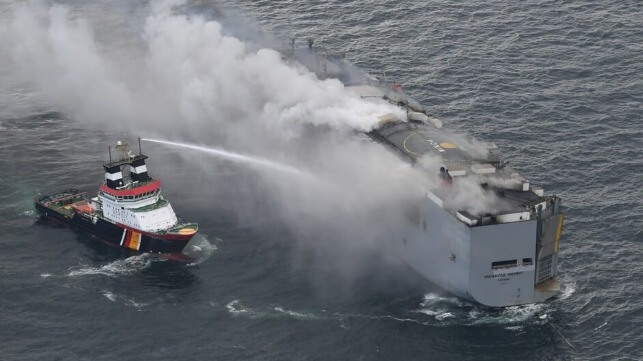Report Details “Confused and Chaotic” Rescue for North Sea Car Carrier Fire

A new report looking at the rescue operation to remove the crew from the burning car carrier Fremantle Highway off the Dutch coast is highly critical of the efforts according to a Dutch newspaper. The analysis is the result of interviews with all the organizations involved in the rescue operation and confirms earlier media reports that said responders were ill-prepared, slow to reach the ship, and disorganized in their efforts.
The Fremantle Highway (18,549 dwt), a Japanese-owned car carrier operating under charter to “K” Line, caught fire overnight on July 25 loaded with more than 3,700 vehicles while sailing off the coast of the Netherlands. The ensuing rescue effort however “was so confusing and chaotic that only ‘professional intuition’ and ‘pragmatic solutions’ prevented” a disaster according to a report prepared by the Trimension agency in Delft, and seen by the newspaper Leeuwaarder Courant.
The fire rendered the lifesaving equipment on the ship inoperable. Ultimately, 16 crewmembers were saved by two helicopters from a private service contracted by the Netherlands Coast Guard. Another seven however chose to jump into the ocean to be rescued by a Coast Guard boat. One of the crewmembers died from injuries sustained from the jump and hitting the water.
The report, however, partially dispels the accusations of a slow response. According to the Leeuwaarder Courant, the first call from the vessel came early on July 26 saying there was a fire but it was under control and that assistance was not required. It took two hours for a Coast Guard plane to overfly the vessel and they reported “radiating heat” saying that they believed evacuation was required as soon as possible.
The newspaper reports the analysis shows the initial wrong assessment of the seriousness delayed the rescue helicopter and that they had initially been prepared to fight the fire, not for an evacuation. They had to hurriedly be converted for the rescue mission.
The report however says the errors began when they offloaded the 16 crewmembers. They assert the helicopter pilots did not know where to go with the rescued crewmembers. They started for a hospital, only to be called back by the control room, which then directed them to the Leeuwarden air base. Further miscommunication the report says then diverted the helicopters yet again finally landing at the Eelde airport, which was not prepared to receive the rescued individuals. The newspaper says ambulances were sent to locked gates and finally a trauma crew at the airport “took pity” and took the crewmembers in until paramedics could get there.
The helicopter crews were also not sure where they were to refuel. One of the two helicopters reportedly landed on a gas drilling platform in the North Sea to refuel before going to the airport. The other left the airport flying to Eemshaven thinking that was where it needed to refuel while it could have refueled at the airport.
In the days after the incident some media reports hinted at the issues uncovered in the report. The newspaper says the report's goal is to highlight the issues to improve future cooperation and coordination. At the same time, the Dutch Safety Board is continuing its investigation into the fire.
The fire burned for days destroying more than 2,000 vehicles and several decks before it burned itself out. The hulk was towed into the Dutch port of Eemshaven arriving on August 3 for a salvage operation.
